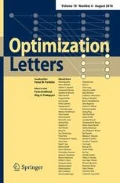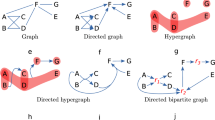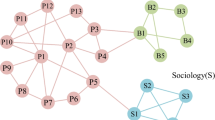Abstract
Detecting low-diameter clusters is an important graph-based data mining technique used in social network analysis, bioinformatics and text-mining. Low pairwise distances within a cluster can facilitate fast communication or good reachability between vertices in the cluster. Formally, a subset of vertices that induce a subgraph of diameter at most k is called a k-club. For low values of the parameter k, this model offers a graph-theoretic relaxation of the clique model that formalizes the notion of a low-diameter cluster. Using a combination of graph decomposition and model decomposition techniques, we demonstrate how the fundamental optimization problem of finding a maximum size k-club can be solved optimally on large-scale benchmark instances that are available in the public domain. Our approach circumvents the use of complicated formulations of the maximum k-club problem in favor of a simple relaxation based on necessary conditions, combined with canonical hypercube cuts introduced by Balas and Jeroslow.
Similar content being viewed by others
Change history
07 June 2018
This article provides an erratum to “Finding a maximum k-club using the k-clique formulation and canonical hypercube cuts,” published online in Optim Lett, 2015
References
Alba, R.D.: A graph-theoretic definition of a sociometric clique. J. Math. Sociol. 3(1), 113–126 (1973)
Almeida, M.T., Carvalho, F.D.: Integer models and upper bounds for the 3-club problem. Networks 60, 155–166 (2012)
Almeida, M.T., Carvalho, F.D.: An analytical comparison of the LP relaxations of integer models for the \(k\)-club problem. Eur. J. Oper. Res. 232(3), 489–498 (2014)
Balas, E., Jeroslow, R.: Canonical cuts on the unit hypercube. SIAM J. Appl. Math. 23(1), 61–69 (1972)
Balasundaram, B.: Graph theoretic generalizations of clique: optimization and extensions. PhD thesis, Texas A&M University, College Station, Texas, USA (2007)
Balasundaram, B., Mahdavi Pajouh, F.: Graph theoretic clique relaxations and applications. In: Pardalos, P.M., Du, D.Z., Graham, R. (eds.) Handbook of Combinatorial Optimization, 2nd edn, pp. 1559–1598. Springer, New York (2013)
Balasundaram, B., Butenko, S., Trukhanov, S.: Novel approaches for analyzing biological networks. J. Comb. Optim. 10(1), 23–39 (2005)
Bourjolly, J.M., Laporte, G., Pesant, G.: Heuristics for finding \(k\)-clubs in an undirected graph. Comput. Oper. Res. 27, 559–569 (2000)
Bourjolly, J.M., Laporte, G., Pesant, G.: An exact algorithm for the maximum \(k\)-club problem in an undirected graph. Eur. J. Oper. Res. 138, 21–28 (2002)
Carvalho, F.D., Almeida, M.T.: Upper bounds and heuristics for the 2-club problem. Eur. J. Oper. Res. 210(3), 489–494 (2011)
Cook, D.J., Holder, L.B.: Graph-based data mining. IEEE Intell. Syst. 15(2), 32–41 (2000)
Dimacs (2012) Graph partitioning and graph clustering: tenth Dimacs implementation challenge. http://www.cc.gatech.edu/dimacs10/index.shtml. Accessed Feb 2015
Gurobi Optimization, Inc (2014) Gurobi optimizer reference manual,version 6.0, copyright \(\copyright \) 2014. http://www.gurobi.com/documentation/6.0/refman/
Kahruman-Anderoglu, S., Buchanan, A., Butenko, S., Prokopyev, O.: On provably best construction heuristics for hard combinatorial optimization problems. Networks. (2015). doi:10.1002/net.21620
Miao, J., Berleant, D.: From paragraph networks to document networks. In: Proceedings of the International Conference on Information Technology: Coding and Computing, 2004 (ITCC 2004), vol. 1, pp 295–302 (2004). doi:10.1109/ITCC.2004.1286469
Mirghorbani, M., Krokhmal, P.: On finding \(k\)-cliques in \(k\)-partite graphs. Optimization Letters. 7(6), 1155–1165 (2013)
Mokken, R.J.: Cliques, clubs and clans. Qual. Quant. 13(2), 161–173 (1979)
Pajouh, F.M., Balasundaram, B.: On inclusionwise maximal and maximum cardinality \(k\)-clubs in graphs. Discret. Optim. 9(2), 84–97 (2012)
Pajouh, F.M., Balasundaram, B., Hicks, I.V.: On the 2-club polytope of graphs (2015, under review)
Pattillo, J., Youssef, N., Butenko, S.: Clique relaxation models in social network analysis. In: Thai, M.T., Pardalos, P.M. (eds.) Handbook of Optimization in Complex Networks. Springer Optimization and Its Applications, vol. 58, pp 143–162. Springer, New York (2012)
Schäfer, A., Komusiewicz, C., Moser, H., Niedermeier, R.: Parameterized computational complexity of finding small-diameter subgraphs. Optim. Lett. 6(5), 883–891 (2012)
Shahinpour, S., Butenko, S.: Algorithms for the maximum \(k\)-club problem in graphs. J. Comb. Optim. 26(3), 520–554 (2013a)
Shahinpour, S., Butenko, S.: Distance-based clique relaxations in networks: \(s\)-clique and \(s\)-club. In: Goldengorin, B.I., Kalyagin, V.A., Pardalos, P.M. (eds.) Models, Algorithms, and Technologies for Network Analysis, vol. 59, pp 149–174. Springer New York (2013b)
Spirin, V., Mirny, L.A.: Protein complexes and functional modules in molecular networks. Proc. Natl. Acad. Sci. 100(21), 12123–12128 (2003)
Terveen, L., Hill, W., Amento, B.: Constructing, organizing, and visualizing collections of topically related, web resources. ACM Trans. Comput. Hum. Interact. 6, 67–94 (1999)
Veremyev, A., Boginski, V.: Identifying large robust network clusters via new compact formulations of maximum \(k\)-club problems. Eur. J. Oper. Res. 218(2), 316–326 (2012)
Veremyev, A., Prokopyev, O.A., Pasiliao, E.L.: Critical nodes for distance-based connectivity and related problems in graphs. Networks 66(3), 170–195 (2015)
Wasserman, S., Faust, K.: Social Network Analysis. Cambridge University Press, New York (1994)
Yannakakis, M.: Node-and edge-deletion NP-complete problems. In: Proceedings of the 10th Annual ACM Symposium on Theory of Computing, STOC ’78, pp. 253–264. ACM Press, New York (1978)
Acknowledgments
The authors would like to thank Dr. Alexander Veremyev for sharing the test-bed from [26] with us. We are also grateful to the referees for their helpful comments, and for pointing out the improved formulation in [27]. The computational experiments reported in this article were conducted at the Oklahoma State University High Performance Computing Center.
Author information
Authors and Affiliations
Corresponding author
Additional information
Authors would like to acknowledge the support of the Air Force Office of Scientific Research Grant FA9550-12-1-0103 and the National Science Foundation Grant CMMI-1404971.
Rights and permissions
About this article
Cite this article
Moradi, E., Balasundaram, B. Finding a maximum k-club using the k-clique formulation and canonical hypercube cuts. Optim Lett 12, 1947–1957 (2018). https://doi.org/10.1007/s11590-015-0971-7
Received:
Accepted:
Published:
Issue Date:
DOI: https://doi.org/10.1007/s11590-015-0971-7




